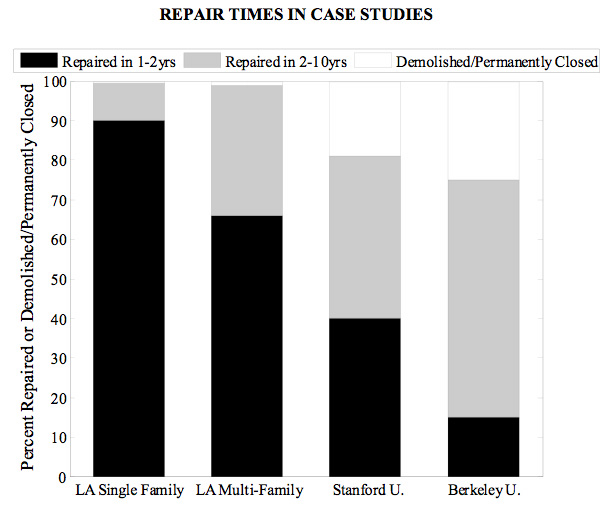Downtime Modeling and Consequences for Decision Variables - 1202005
| Project Title—ID Number | Downtime Modeling and Consequences for Decision Variables - 1202005 |
| Start/End Dates | 10/1/05 – 9/30/06 |
| Funding Source | PEER-CA-Gen |
| Project Leader (boldface) and Other Team Members | Mary Comerio (UCB/F), Howard Blecher (UCB/GS), Gee Heckscher (Architectural Resources Group/I), Craig Comartin (Comartin Consulting/I), Charles Kircher (Comartin Consulting/I) |
Project goals and objectives
This project will complete the work on downtime modeling developed in Year 8, in coordination with Prof. Jim Beck at Cal Tech. In addition, we will apply the model to the U. C. Berkeley campus, in order to test the PEER loss modeling methodology.
Role of this project in supporting PEER's mission (vision)
This is part of the "packaging" effort to bring PEER performance based design methods into professional practice.
Methodology employed
Detailed case studies of downtime from past earthquakes have been used to provide data for the loss model developed at Cal Tech, and then input into a loss estimation for the UC Berkeley campus.
Brief Description of previous year's achievements, with emphasis on accomplishments during last year (Year 8)
This is an outgrowth of the previous year's work, and an application of it. Comerio has published two articles: "Downtime Modeling For Risk Management" Safety and Reliability of Engineering Systems and Structures, G. Augusti, G.I. Schueller, M. Ciampoli (eds.) ICOSSAR 2005, Rome, June 2005; and "Estimating Downtime in Loss Modeling" Earthquake Spectra, Vol. 22, No. 2, May 2006. These articles outline the theory, methods, and data needs of downtime modeling issues.
Other similar work being conducted within and outside PEER and how this project differs
This is similar to work underway to revise and improve the HAZUS loss estimating software, but the PEER methodology is building specific and will be adopted by Applied Technology Council for ATC 58. Our approach is not really similar to any other loss estimating methods.
Describe any instances where you are aware that your results have been used in industry
The UC Berkeley Capital Projects Office has received funding for a computer-based loss modeling effort that is based on the Disaster Resistant University loss estimate (Comerio, 2000). Craig Comartin and Charles Kircher are developing the new loss estimate and my plan to work in coordination with that effort to revisit the estimates of downtime, based on my Year 9 PEER research.

Back to Funded Project Archive main page

